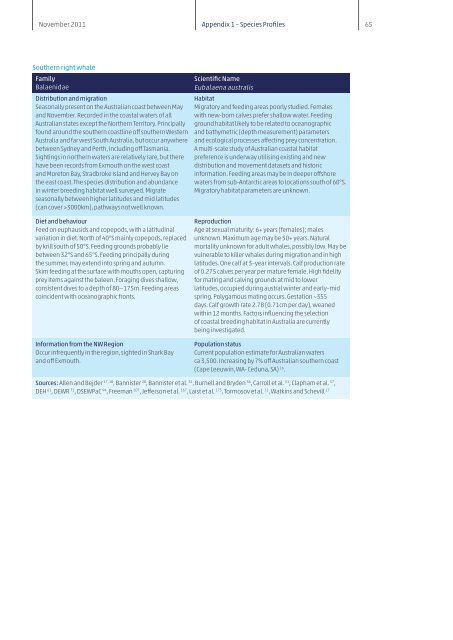Australia's last great whale haven.pdf - Ningaloo Atlas
Australia's last great whale haven.pdf - Ningaloo Atlas
Australia's last great whale haven.pdf - Ningaloo Atlas
- TAGS
- whale
- ningaloo
- atlas
- www.ifaw.org
Create successful ePaper yourself
Turn your PDF publications into a flip-book with our unique Google optimized e-Paper software.
November 2011 Appendix 1 – Species Profiles<br />
65<br />
Southern right <strong>whale</strong><br />
Family<br />
Balaenidae<br />
Distribution and migration<br />
Seasonally present on the Australian coast between May<br />
and November. Recorded in the coastal waters of all<br />
Australian states except the Northern Territory. Principally<br />
found around the southern coastline off southern Western<br />
Australia and far west South Australia, but occur anywhere<br />
between Sydney and Perth, including off Tasmania.<br />
Sightings in northern waters are relatively rare, but there<br />
have been records from Exmouth on the west coast<br />
and Moreton Bay, Stradbroke Island and Hervey Bay on<br />
the east coast. The species distribution and abundance<br />
in winter breeding habitat well surveyed. Migrate<br />
seasonally between higher latitudes and mid latitudes<br />
(can cover >3000km), pathways not well known.<br />
Diet and behaviour<br />
Feed on euphausids and copepods, with a latitudinal<br />
variation in diet. North of 40°S mainly copepods, replaced<br />
by krill south of 50°S. Feeding grounds probably lie<br />
between 32°S and 65°S. Feeding principally during<br />
the summer, may extend into spring and autumn.<br />
Skim feeding at the surface with mouths open, capturing<br />
prey items against the baleen. Foraging dives shallow,<br />
consistent dives to a depth of 80—175m. Feeding areas<br />
coincident with oceanographic fronts.<br />
Information from the NW Region<br />
Occur infrequently in the region, sighted in Shark Bay<br />
and off Exmouth.<br />
Scientific Name<br />
Eubalaena australis<br />
Habitat<br />
Migratory and feeding areas poorly studied. Females<br />
with new-born calves prefer shallow water. Feeding<br />
ground habitat likely to be related to oceanographic<br />
and bathymetric (depth measurement) parameters<br />
and ecological processes affecting prey concentration.<br />
A multi-scale study of Australian coastal habitat<br />
preference is underway utilising existing and new<br />
distribution and movement datasets and historic<br />
information. Feeding areas may be in deeper offshore<br />
waters from sub-Antarctic areas to locations south of 60°S.<br />
Migratory habitat parameters are unknown.<br />
Reproduction<br />
Age at sexual maturity: 6+ years (females); males<br />
unknown. Maximum age may be 50+ years. Natural<br />
mortality unknown for adult <strong>whale</strong>s, possibly low. May be<br />
vulnerable to killer <strong>whale</strong>s during migration and in high<br />
latitudes. One calf at 3–year intervals. Calf production rate<br />
of 0.275 calves per year per mature female. High fidelity<br />
for mating and calving grounds at mid to lower<br />
latitudes, occupied during austral winter and early–mid<br />
spring. Polygamous mating occurs. Gestation ~355<br />
days. Calf growth rate 2.78 (0.71cm per day), weaned<br />
within 12 months. Factors influencing the selection<br />
of coastal breeding habitat in Australia are currently<br />
being investigated.<br />
Population status<br />
Current population estimate for Australian waters<br />
ca 3,500. Increasing by 7% off Australian southern coast<br />
(Cape Leeuwin, WA- Ceduna, SA) 16 .<br />
Sources: Allen and Bejder 17, 18 , Bannister 28 , Bannister et al. 31 , Burnell and Bryden 36 , Carroll et al. 51 , Clapham et al. 57 ,<br />
DEH 61 , DEWR 71 , DSEWPaC 94 , Freeman 107 , Jefferson et al. 167 , Laist et al. 175 , Tormosov et al. 11 , Watkins and Schevill 17

















